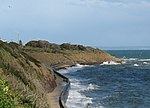Half Moon Bay (Victoria)

The Half Moon Bay is a bay and neighbourhood on Port Phillip, south east of Melbourne. Located in the suburb of Black Rock, it is home to the Black Rock Yacht Club, the Half Moon Bay Lifesaving Club and the Cerberus Beach House Restaurant and Beach Kiosk. This bay also gets a mention in the Cat Empire song, "The Wine Song". Half Moon Bay is also home to HMVS Cerberus, the last surviving monitor warship in the world, which acts as a breakwater. Half Moon Bay has a lifesaving club and a pier and has the Red Bluff Cliffs just along the beach. The cliffs were briefly featured in the movie "Mad Max'" as well as the 90's children's television series "Round The Twist". Half Moon Bay also has aquatic life which makes good snorkelling. It features many coastal processes. The first Black Rock Post Office opened here on 23 April 1902, was renamed Half Moon Bay in 1922 and closed in 1968.There are two other Half Moon Bays in Port Phillip. One at Mount Eliza, Victoria and another at Indented Head, Victoria. There is also another Half Moon Bay near Torquay, Victoria.
Excerpt from the Wikipedia article Half Moon Bay (Victoria) (License: CC BY-SA 3.0, Authors, Images).Half Moon Bay (Victoria)
Bay Trail, Melbourne Black Rock
Geographical coordinates (GPS) Address Nearby Places Show on map
Geographical coordinates (GPS)
| Latitude | Longitude |
|---|---|
| N -37.966944444444 ° | E 145.01083333333 ° |
Address
Bay Trail
Bay Trail
3191 Melbourne, Black Rock
Victoria, Australia
Open on Google Maps





